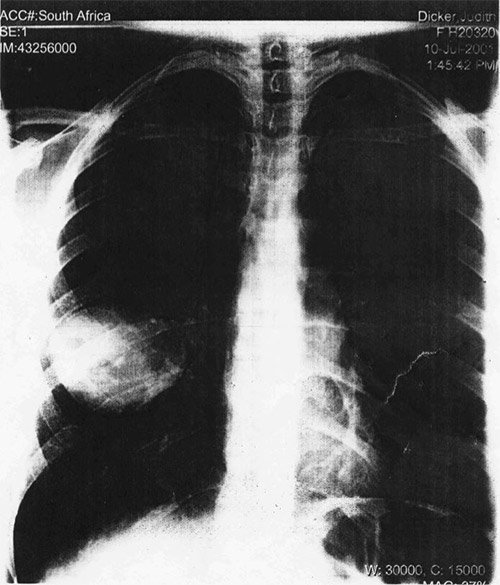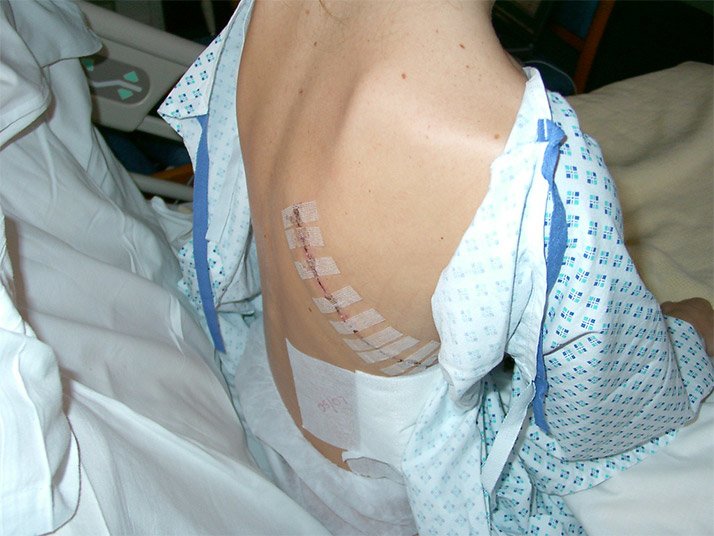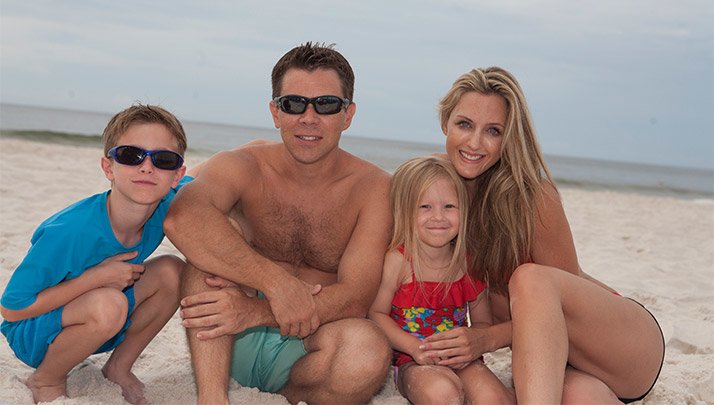
Losing A Lung, Gaining Fitness
After having most of one lung removed, Judith Dicker defied the odds by getting fit. Then she went the extra mile and became a national-level physique competitor!
People often resent the inconvenience of airport security, but it probably saved Judith Dicker's life. In 2000, she was forced to undergo a chest X-ray at Heathrow Airport in London.
"I was moving from Port Elizabeth in South Africa to begin a new job in banking," she explains. British officials required an up-to-date chest X-ray of all South African citizens, hoping to prevent tuberculosis from entering their country. Judith's X-ray revealed an object, about the size of a tennis ball, in her right lung. After multiple other tests, she was considered free of tuberculosis and able to enter the country.
Remarkably, no one at the time, including Judith, bothered to determine the nature of this large object.
She would regret that oversight two years later.
Take My Breath Away
One night in 2002, Judith awoke gasping for breath, unable to inhale as much oxygen as she needed. "I started coughing, and I couldn't stop," she says. Then I couldn't breathe." Her husband rushed her to the hospital.
Luckily, she had kept the X-ray from Heathrow and was able to present it to her London doctor. "When the doctors saw my X-ray, they knew my condition was serious," she says. "If I hadn't had that with me, I think I may have died."

She was also lucky that her doctor was familiar with hydatid disease, a cystic condition Judith developed due to a parasite she was exposed to growing up on a farm in South Africa. While generally rare, the disease is not uncommon in the rural setting where Judith lived until she was 13. It's caused by a tapeworm, of all things.
Judith's lung had filled with fluid, and she developed pneumonia, staying in the hospital for two weeks. "One day while I was in the hospital, I was talking to my parents in South Africa, and I couldn't continue the phone conversation because I couldn't breathe," remembers Judith. She had to hand the phone over to her boyfriend, and he tried to explain the gravity of the situation to Judith's parents.
Blood tests determined that the microorganism responsible for the condition remained present and active. After she recovered from pneumonia, Judith was discharged from the hospital. Her doctors had decided the best course of action was to monitor the condition rather than perform surgery. "They gave me medication, similar to a cancer drug, that would help break down the cyst," she says.
But she developed another case of pneumonia four months later and had to be hospitalized yet again. They told her such bouts of pneumonia were likely to persist. They now believed the best course of action was to remove the cyst, which would also entail removal of part or all of her right lung.
Waiting to Inhale
Judith's doctors told her that she was lucky that the cyst was on the right side. That way, they could operate from the back, rather than enter through the chest and navigate around the heart. Nevertheless, the incision would have to be big enough to allow the doctor to separate her ribs and cut out the cyst. "I asked my surgeon how large the cut and scar would be, and he showed me his hand," she recalls.
During surgery, the medical team discovered greater damage in Judith's right lung than they had expected. The best course of action was to remove nearly all of that lung. Otherwise, whenever she contracted a cold in the future, it would be very easy for her lungs to fill with fluid. Even a small cold could quickly become life-threatening.
After the large obstruction and most of her lung was surgically removed, Judith continued to struggle while recuperating in the hospital. Clearly, something else was wrong. Eventually, doctors determined that she had an air leak in her lung, caused by the surgery. "They had to put a suction pipe into my lung to prevent it from collapsing, and I had to stay in the hospital for about four weeks after the surgery, until both the surgery and leak healed," she recalls.

During this time, Judith found it nearly impossible to get out of bed, and her hair began to fall out. "The nursing staff cheered for me the first time I was able to walk down the hall with my husband's help," she says. When she was dismissed, her doctors advised Judith that, as a person with only one lung, and she needed to take it easy.
They suggested she limit herself to moderate activity, such as daily walks. They advised against strenuous activity. Only, Judith couldn't accept that.
Every Breath You Take
"It felt like they were talking to me like I was an old, feeble woman," Judith recalls of her doctors. As thankful as she was to have been given a new lease on life, she felt defeated by these new rules. For example, she was advised to walk 30 minutes every other day, but never to exert herself to the point where she felt out of breath.
Easy enough, right? On the contrary, Judith found that this level of conditioning was only sufficient to keep her feeling weak during normal, everyday activities.
One day, though, the escalator from the underground up to street level was broken. "I struggled to make my way up the stairs to the point where I grew anxious," she recalls. People pushed Judith, jostling into her.
"That was my turning point," Judith says. "I wasn't ready to accept this limited lifestyle. I have always believed that we set our own limitations and that we are only as smart, brave, or strong as we believe." She began to disobey her doctor's orders by gradually introducing more strenuous cardio activity into her daily life. It felt good, so she kept upping the ante. "I signed up for a 5K in London about four months later."
Judith also earned her certification as a group fitness instructor, and she began to teach step and body conditioning, all during the first year after her surgery. "It was difficult for me because I was still struggling to breathe and just beginning to get back my energy," she recalls. But even in its compromised state, her body responded to the stimulus—partially because she also took this as an opportunity to get serious about healthy eating.
Against all expectations, Judith was getting stronger.
Every Move You Make
At her one-year follow-up after surgery, Judith's doctors couldn't believe her remarkable recovery. "They were amazed to see my remaining lung's capacity, and they told me that they were going to note my course of improvement, and potentially recommend a more strenuous regimen for otherwise healthy people who had lost the use of a lung," she says.

In 2003, Judith and her husband immigrated to the United States, where she began cycling 80 miles a week. Then she started training for a half-marathon, and the trajectory she had established in London continued. "The more I exercised, the healthier I felt," she recalls.
Today, the couple has two children. "I was very healthy during both pregnancies," she says. During this phase of her life, doctors began to encourage pregnant women to exercise more, based on science—another motivation for Judith to keep training.
By the time her children were born, training and fitness had become a way of life for Judith. She saw a commercial for Insanity by Beachbody, which inspired her to focus on another aspect of fitness and increase muscle tone. It was yet another challenge that her body responded to with relish—once she gave it the chance.
"Weight training was very hard for me at first," she recalls. "I struggled to perform one regular push-up." But, by the end of 60 days, Judith couldn't believe how different her body felt. She was hooked on feeling strong by performing resistance exercise.
The Next Level of Fitness
In 2012, a Web search directed her to Jamie Eason's LiveFit program on Bodybuilding.com. Eason's appearance and approach resonated with Judith immediately. "I loved how strong she looked, and I began following her fitness, nutrition, and supplementation regimens," she says.
Based on Judith's progress, a friend suggested she look into competing in the NPC. "I didn't think I had what it would take, especially because of the large scar on my back," she recalls. But, of course, that was only one way to look at it. Ultimately, she decided to compete in order to gain exposure to share her story with others.

With the aid of a trainer, she entered her first NPC bikini show, the Branch Warren Classic, in 2014, placing sixth in the bikini open division. In 2015, she placed second at the same show, qualifying her for national-level competition.
Today, Judith is putting her training energy and focus into her next competition, planning to compete for her pro card. She's currently eyeing the NPC USA in Las Vegas in July 2016.
Now, Judith trains as hard as she is able to, emphasizing cardio and bringing up her shoulders and legs. She has close to the cardiovascular ability of a person with two lungs. While she can now breathe easy, competitors in her class shouldn't when she steps onstage with them.
